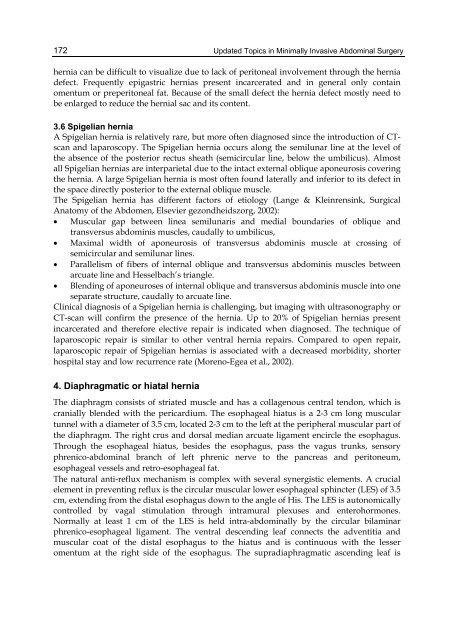UPDATED TOPICS IN MINIMALLY INVASIVE ABDOMINAL SURGERY
UPDATED TOPICS IN MINIMALLY INVASIVE ABDOMINAL SURGERY
UPDATED TOPICS IN MINIMALLY INVASIVE ABDOMINAL SURGERY
Create successful ePaper yourself
Turn your PDF publications into a flip-book with our unique Google optimized e-Paper software.
172<br />
Updated Topics in Minimally Invasive Abdominal Surgery<br />
hernia can be difficult to visualize due to lack of peritoneal involvement through the hernia<br />
defect. Frequently epigastric hernias present incarcerated and in general only contain<br />
omentum or preperitoneal fat. Because of the small defect the hernia defect mostly need to<br />
be enlarged to reduce the hernial sac and its content.<br />
3.6 Spigelian hernia<br />
A Spigelian hernia is relatively rare, but more often diagnosed since the introduction of CTscan<br />
and laparoscopy. The Spigelian hernia occurs along the semilunar line at the level of<br />
the absence of the posterior rectus sheath (semicircular line, below the umbilicus). Almost<br />
all Spigelian hernias are interparietal due to the intact external oblique aponeurosis covering<br />
the hernia. A large Spigelian hernia is most often found laterally and inferior to its defect in<br />
the space directly posterior to the external oblique muscle.<br />
The Spigelian hernia has different factors of etiology (Lange & Kleinrensink, Surgical<br />
Anatomy of the Abdomen, Elsevier gezondheidszorg, 2002):<br />
Muscular gap between linea semilunaris and medial boundaries of oblique and<br />
transversus abdominis muscles, caudally to umbilicus,<br />
Maximal width of aponeurosis of transversus abdominis muscle at crossing of<br />
semicircular and semilunar lines.<br />
Parallelism of fibers of internal oblique and transversus abdominis muscles between<br />
arcuate line and Hesselbach’s triangle.<br />
Blending of aponeuroses of internal oblique and transversus abdominis muscle into one<br />
separate structure, caudally to arcuate line.<br />
Clinical diagnosis of a Spigelian hernia is challenging, but imaging with ultrasonography or<br />
CT-scan will confirm the presence of the hernia. Up to 20% of Spigelian hernias present<br />
incarcerated and therefore elective repair is indicated when diagnosed. The technique of<br />
laparoscopic repair is similar to other ventral hernia repairs. Compared to open repair,<br />
laparoscopic repair of Spigelian hernias is associated with a decreased morbidity, shorter<br />
hospital stay and low recurrence rate (Moreno-Egea et al., 2002).<br />
4. Diaphragmatic or hiatal hernia<br />
The diaphragm consists of striated muscle and has a collagenous central tendon, which is<br />
cranially blended with the pericardium. The esophageal hiatus is a 2-3 cm long muscular<br />
tunnel with a diameter of 3.5 cm, located 2-3 cm to the left at the peripheral muscular part of<br />
the diaphragm. The right crus and dorsal median arcuate ligament encircle the esophagus.<br />
Through the esophageal hiatus, besides the esophagus, pass the vagus trunks, sensory<br />
phrenico-abdominal branch of left phrenic nerve to the pancreas and peritoneum,<br />
esophageal vessels and retro-esophageal fat.<br />
The natural anti-reflux mechanism is complex with several synergistic elements. A crucial<br />
element in preventing reflux is the circular muscular lower esophageal sphincter (LES) of 3.5<br />
cm, extending from the distal esophagus down to the angle of His. The LES is autonomically<br />
controlled by vagal stimulation through intramural plexuses and enterohormones.<br />
Normally at least 1 cm of the LES is held intra-abdominally by the circular bilaminar<br />
phrenico-esophageal ligament. The ventral descending leaf connects the adventitia and<br />
muscular coat of the distal esophagus to the hiatus and is continuous with the lesser<br />
omentum at the right side of the esophagus. The supradiaphragmatic ascending leaf is














![focuspdca.ppt [Compatibility Mode]](https://img.yumpu.com/22859457/1/190x146/focuspdcappt-compatibility-mode.jpg?quality=85)


